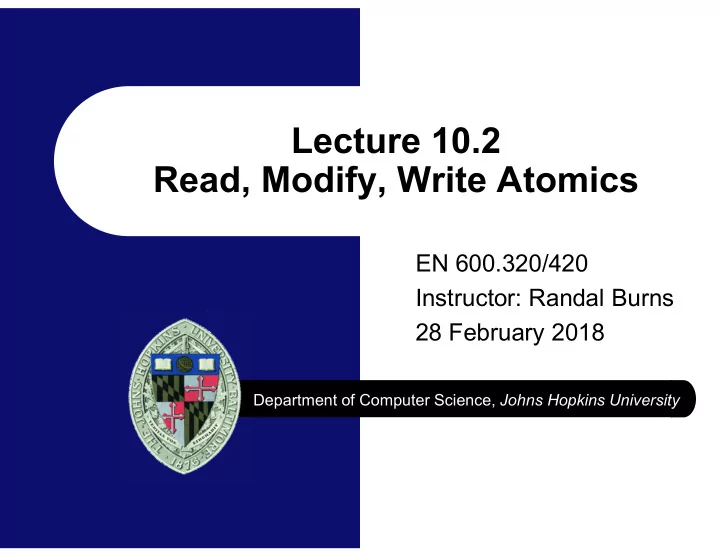

Lecture 10.2 Read, Modify, Write Atomics EN 600.320/420 Instructor: Randal Burns 28 February 2018 Department of Computer Science, Johns Hopkins University
The Next Layer of Concepts Variants on number of processes – Infinitely many processes – Sparse process id address space (symmetric algs.) Spinning on local registers only For different memory models – CC, DSM Lecture 13: Introduction to Synchronization
Building on Primitives Common atomic operations (building blocks): – Read – Write – Test-and-set – Swap – Fetch and add (fetch and increment) – Read-modify-write – Compare-and-swap Lecture 13: Introduction to Synchronization
Test-and-Set Bit Two operations – Reset: write 0 – Test and set: write 1 and return old value Trivial deadlock free synchronization await (test-and-set(x) = 0); critical section reset(x); This is called a spin lock – Mutual exclusion, deadlock free – Not starvation resistant Lecture 13: Introduction to Synchronization
Test-and-Test-and-Set Bit Test-and-set alg. writes bit every iteration – Invalidates caches even when data don’t change Test-and-test-and-set – Supports test w/out set Produces fewer cache misses – What’s the miss pattern during contention await (x=0); while (test-and-set(x) = 1) do await (x=0) od; critical section reset(x); Lecture 13: Introduction to Synchronization
What’s wrong with Spin Locks? Every process spins on shared state When lock is freed, all processes attempt to acquire Performance varies with contention: – Low contention good (simple algorithms) – High contention bad (burst of activity: messages and cache invalidations) Can be addressed with backoff policies – Like exponential backoff in TPC But, queuing is better Lecture 13: Introduction to Synchronization
Ticket Algorithm Bakery algorithms using read-modify-write – < and > indicate RMW boundaries Lecture 13: Introduction to Synchronization
Properties of RMW Ticket Alg. FIFO: in the order of successful RMW Mutual exclusion and deadlock freedom Uses one shared register that holds n 2 values This is the power of H/W support – Modern processors provide some variant of RMW Lecture 13: Introduction to Synchronization
Waiting w/out the Busy Wait The Semaphore S – up( S ) increase the value of S – down( S ) decrease the value of S – Binary semaphore takes values 0 and 1 Using the semaphore – down( S ); critical section; up( S ); – To realize deadlock-free, mutual exclusion Where does the busy wait go? – Nowhere: implement semaphores with test-and-set – Into the kernel: one process does all the busy waiting – Into hardware: use interrupts Lecture 13: Introduction to Synchronization
Barriers Allows a “synchronous” algorithm to run on asynchronous hardware Lecture 13: Introduction to Synchronization
Simple Barrier Built on an atomic counter and atomic bits Lecture 13: Introduction to Synchronization
Recommend
More recommend